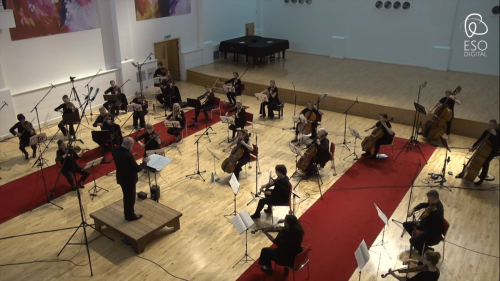 United Kingdom Elgar reimagined, Elgar (arr. David Matthews): English Symphony Orchestra / Kenneth Woods (conductor). Wyastone Concert Hall, Monmouth. Relayed via the ESO’s YouTube channel, 14.5.2021. (JQ)
United Kingdom Elgar reimagined, Elgar (arr. David Matthews): English Symphony Orchestra / Kenneth Woods (conductor). Wyastone Concert Hall, Monmouth. Relayed via the ESO’s YouTube channel, 14.5.2021. (JQ)

Elgar (arr. David Matthews) – String Quartet in E minor, Op.83
In the closing years of the second decade of the twentieth century Elgar composed four works, three of them chamber works, all of which were cast in minor keys. The last of these to be composed was the Cello Concerto, Op.85 (1919). The preceding works, all completed in 1918, were the Violin Sonata, Op.82, the String Quartet, Op.83, and the Piano Quintet, Op.84. With the exception of the Piano Quintet, which has A minor as its home key, all of these works were cast in the same home key of E minor. I think it would be fair to say that over the years the three chamber works have not received their full due other than from committed Elgar enthusiasts. Indeed, even though a number of distinguished cellists took up the Cello Concerto, it was not until the celebrated recording by Jacqueline Du Pré and Sir John Barbirolli in the 1960s that the musical public really took the work to their hearts. Yet the trio of late chamber works contains a great deal of fine music which deserves a wide audience.
The Piano Quintet was orchestrated a while ago by Donald Fraser and has been recorded by Kenneth Woods and the ESO. I have never heard that orchestration, though the CD was reviewed by my MusicWeb International colleague Gwyn Parry-Jones. David Matthews made his arrangement of the String Quartet at the suggestion of the conductor George Vass. It was first performed at the Presteigne Festival in 2010, though this present performance was my first opportunity to hear it.
Kenneth Woods performed it with an orchestra comprising (if I have counted correctly) 14 violins, four violas, four cellos and two double basses. The viola section was positioned on the conductor’s right, with the cellos between the violas and the second violins. I think it is relevant to mention the number of players involved in order to make a point of comparison with Elgar’s celebrated Introduction and Allegro. Elgar deliberately designed that masterpiece for performance by the full string section of a symphony orchestra (originally the LSO). I suppose it would be feasible to play David Matthews’s arrangement of the Quartet with a full-sized string band. However, I am not sure that would work so well because, after all, the Quartet is essentially an intimate piece whereas the Introduction and Allegro is a big, public composition. It seemed to me that Kenneth Woods had elected to use just the right number of string players. With these forces he demonstrated that Matthews has made the Quartet into a bigger piece but without losing sight of the spirit of the original.
The work has three movements. Right from the start of the first movement, marked Allegro moderato, I was struck by the fine, full sound of the ensemble. It was particularly pleasing to hear a strong, rich – but not overpowering – bass line. The main theme of the movement is quintessentially Elgarian and the music benefitted from the generous tone produced by more than four instruments. I noted a couple of short passages in which Matthews used just the section principals as a quartet; those brief intervals produced a useful contrast. The full string complement was a decided asset in projecting the several passionate episodes in the movement.
The slow movement is marked Piacevole (poco andante). The equivalent movement in the Violin Sonata is a strange, inward-looking piece. On the surface at least, the Quartet’s slow movement is less complex. Indeed, in the opening pages, and elsewhere in the movement, Elgar seems to be looking back to the lyricism of his earlier years, albeit refracted through a lens of melancholy. The present performance had a nice, easy flow to it and I thought that Woods conducted very intelligently, allowing the music to make its mark without undue intervention. There’s lovely music in this movement and it was very well played.
In the finale there was a richness and brilliance in the Allegro molto passages which, obviously, exceeded the tonal resources of a string quartet; thus, an extra dimension was added to Elgar’s music. The more reflective episodes were played with sensitivity but it was, above all, the sweep that Woods and his players brought to the quick passages that left the strongest impression.

I think David Matthews’s arrangement of Elgar’s String Quartet is a conspicuous success. His work seems to me to have been undertaken in complete sympathy with Elgar’s original, but he has enabled us to hear the music in a fresh way. Thus, the title given to this presentation, ‘Elgar reimagined’, was entirely apt. Matthews’s arrangement works on another level too; it adds to the string orchestra repertoire music by Elgar in a version that sounds completely authentic. I thought he was especially successful in the way he added the extra depth and resonance of a couple of double basses to reinforce the bass line but in such a way that never made the music seem bottom-heavy. Kenneth Woods and the string players of the English Symphony Orchestra gave a performance that showed Matthews’s work to best possible advantage.
The performance, which is presented in good sound and visuals, is available to stream on demand (click here).
John Quinn
